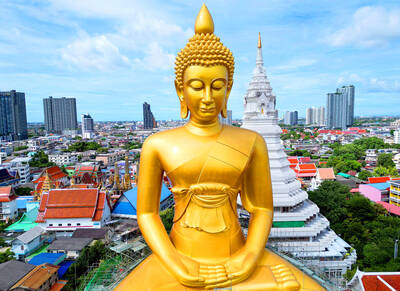Dozens of artists in the eastern Indian state of Bihar are painting roadside trees and their leaves with colorful stories from Hindu epics, hoping to save the region’s already critically sparse greenery.
The unusual campaign, using coats of paint and brushes, has been launched in Madhubani, a northern Bihar district known for its religious and cultural awareness, resulting in hundreds of otherwise untended roadside trees covered in elaborate artwork.
Artists are depicting the moods of deities, scenes from Hindu classics such as the Ramayana and Mahabharata, or an imaginary scene showing an elderly woman restraining a man coming with an axe to cut trees.
They believe the artwork will prompt the deeply religious locals to drop any idea of cutting down the trees out of fear of incurring the wrath of the deities.
“We are using the deities as a cover,” said Shashthi Nath Jha, who also runs a non-governmental organization dedicated to empowering women and child laborers, speaking by telephone from Madhubani, about 1,200km east of New Delhi.
“We thought people will not do any harm to trees once they come across the images of gods and goddesses on them,” Jha said
According to Bihar state records, the forest coverage of the state, which suffers from recurring floods, is currently just under 7 percent.
The tree painting campaign began in September this year after Jha managed to overcome numerous local objections, including doubt that the campaign would last long, worries about how much the paint cost and fears the colors would soon fade.
“I had to convince them a lot before they agreed to join me,” Jha said. “I made several experiments to check the durability of the paint in the open. Finally we decided to apply a mix of natural and artificial paints to ensure the painting survives the fast-changing weather conditions.”
They work in the style of Madhubani painting, a form of Indian painting done with fingers, twigs, the points of fountain pens and even matchsticks, using natural colors and characterized by brilliant geometrical patterns.
“I have painted themes of ‘Sita-swayamvara’ [the marriage of the deities Rama and Sita] on the tree trunks so that those willing to cut them would drop the idea,” 19-year-old Kushaboo told local media.
According to Jha, the initiative has drawn the attention of the international community as well, with a team from Switzerland recently visiting to study how art could be used to convey a strong social message.
The government is taking additional steps to increase greenery in the region, with plans to plant 250 million saplings in the next five years and appointing “Tree Friends” to care for young trees planted along roads and other public places.
However, Jha said locals also had a debt of sorts to repay.
“Plants and trees have brought color to our life. Now it’s our duty to put color on them,” Jha said.

The military is to begin conscripting civilians next year, Cambodian Prime Minister Hun Manet said yesterday, citing rising tensions with Thailand as the reason for activating a long-dormant mandatory enlistment law. The Cambodian parliament in 2006 approved a law that would require all Cambodians aged 18 to 30 to serve in the military for 18 months, although it has never been enforced. Relations with Thailand have been tense since May, when a long-standing territorial dispute boiled over into cross-border clashes, killing one Cambodian soldier. “This episode of confrontation is a lesson for us and is an opportunity for us to review, assess and

IDENTITY: A sex extortion scandal involving Thai monks has deeply shaken public trust in the clergy, with 11 monks implicated in financial misconduct Reverence for the saffron-robed Buddhist monkhood is deeply woven into Thai society, but a sex extortion scandal has besmirched the clergy and left the devout questioning their faith. Thai police this week arrested a woman accused of bedding at least 11 monks in breach of their vows of celibacy, before blackmailing them with thousands of secretly taken photos of their trysts. The monks are said to have paid nearly US$12 million, funneled out of their monasteries, funded by donations from laypeople hoping to increase their merit and prospects for reincarnation. The scandal provoked outrage over hypocrisy in the monkhood, concern that their status

The United States Federal Communications Commission said on Wednesday it plans to adopt rules to bar companies from connecting undersea submarine communication cables to the US that include Chinese technology or equipment. “We have seen submarine cable infrastructure threatened in recent years by foreign adversaries, like China,” FCC Chair Brendan Carr said in a statement. “We are therefore taking action here to guard our submarine cables against foreign adversary ownership, and access as well as cyber and physical threats.” The United States has for years expressed concerns about China’s role in handling network traffic and the potential for espionage. The U.S. has

A disillusioned Japanese electorate feeling the economic pinch goes to the polls today, as a right-wing party promoting a “Japanese first” agenda gains popularity, with fears over foreigners becoming a major election issue. Birthed on YouTube during the COVID-19 pandemic, spreading conspiracy theories about vaccinations and a cabal of global elites, the Sanseito Party has widened its appeal ahead of today’s upper house vote — railing against immigration and dragging rhetoric that was once confined to Japan’s political fringes into the mainstream. Polls show the party might only secure 10 to 15 of the 125 seats up for grabs, but it is